Physical determinants of life (atmosphere and climate) [EN-ES]
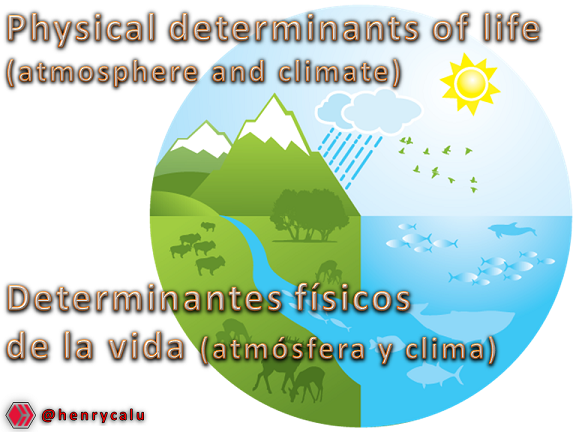
Physical determinants of life
(atmosphere and climate)
(atmosphere and climate)
In the study of Ecology, we can find the relationship of living beings with their natural environment, which is called ecosystem, within which we can find the abiotic factors, which are essential for the development of the biotic factors of any ecosystem, since organisms recycle their chemical components and need physical and chemical conditions to carry out their work; these conditions are: solar energy, nutrients, water, gases, temperature and soil.
“…abiotic factors or abiotic components are the non-living chemical and physical components of the environment that affect living organisms and the functioning of ecosystems. All non-living components of an ecosystem, such as atmospheric conditions, water resources, gases, concentrations of organic and inorganic substances and energy flows, are therefore called abiotic factors. Among the most important we can find: water, air, temperature, light, pH, soil, humidity, oxygen and different nutrients…”
When analyzing the biogeochemical water cycle, it can be found that abiotic factors (such as sunlight, climate, water and soil) constantly intervene in its development.
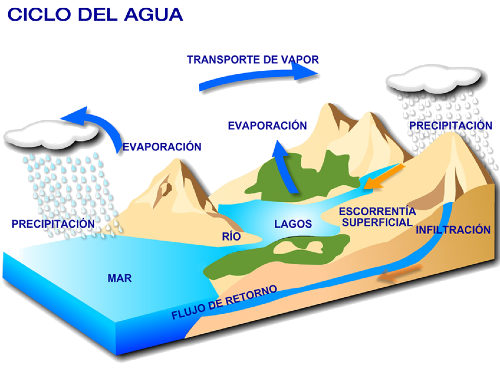
The chemical and physical conditions of the entire ecosystem vary, originating that living organisms must be in competition to be tolerant to these climatic changes and seek the ability to adapt to them; however, there are tolerance limits that can cause alterations in the ecosystem. If these climatic variations are very severe, living organisms, if they are not able to resist such change and adapt slowly, die; others that have the capacity to disperse, can migrate and colonize other places more favorable for their existence. In this sense, the factors that determine the distribution of species are called limiting factors. Likewise, abiotic factors are modified by the influence of life.
The conditions that make life possible on the planet take place in a thin layer of air, water and land, known as the biosphere. The atmosphere is the gaseous layer that surrounds the earth; it is a fluid shell made up of gases and water.
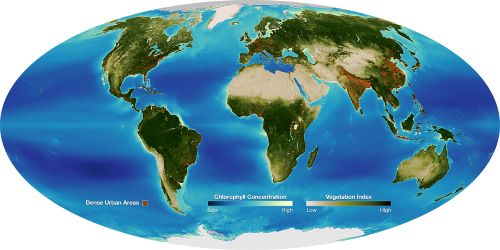
The volume occupied by these gases, as a percentage of the partial pressure, is approximately as follows:
- Nitrogen (N), 78.085%.
- Oxygen (O), 20.946%.
- Argón (Ar), 0,934%
- Carbon dioxide (CO2), 0.033%
In addition, the atmosphere contains water in the form of vapor. Through the process of evaporation, water is constantly circulating. Evapotranspiration means: the water that plants let escape through the stomata of their foliage. Therefore, the amount of vegetation present in a place will determine the degree of evapotranspiration, a value that also depends on the temperature and climate of the place.
Temperature and its variations constitute a limiting abiotic factor in the distribution of plants and animals. Each species has an upper and lower temperature limit beyond which it dies when its limit is altered.
The sunlight that reaches the Earth is largely absorbed, partly reflected and scattered. Light is a stimulus that determines the behavior and responses of many animals, allowing, for example, synchrony in the mating seasons: where a certain number of various species (birds, fish, mammals, insects, etc.), are concentrated in various places (ecosystems) that meet certain conditions to multiply their species. On the other hand, sunlight is necessary for >b>Photosynthesis and determines the distribution of plants according to light requirements, since some plants do not tolerate shade, while others need it.
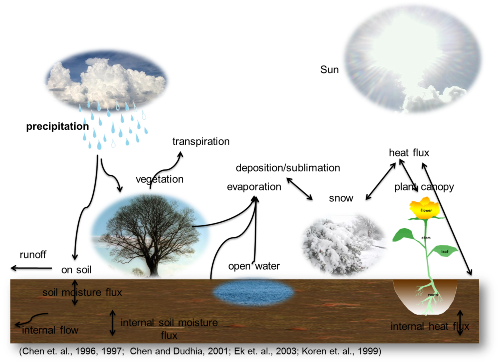
In the polar and subtropical zones, sunlight strikes obliquely and brings less thermal energy to the Earth's surface, because the radiant energy is spread over a larger area and must pass through a thicker layer of the atmosphere subject to processes of absorption, scattering and solar reflection. On the contrary, the perpendicular rays that fall on the tropics transfer more thermal energy to the earth's surface (it can be said that they arrive more directly).
The atmosphere is not static, circulation and movement are permanent. This circulation contributes to the dispersion of organisms, especially insects and seeds. The emigration of insects and birds is associated with the highest wind currents.
So then, sunlight, water, air or winds, soil and climate in general, are part of the abiotic factors, they actively compose the terrestrial ecosystem, they do not possess life but are influential, to a great extent, on living beings, which form the biotic factors.
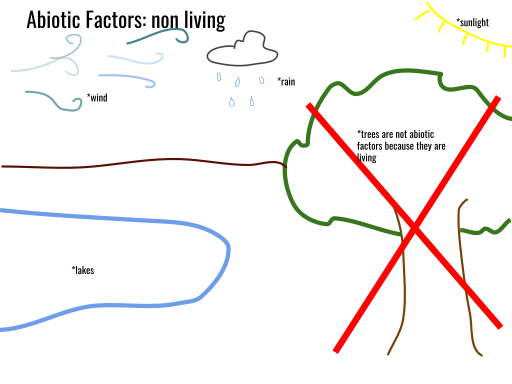
Thank you for reading this publication !
And remember to always practice
the love of nature,
the Creator of the Universe
will reward you !
✧✦✧ @henrycalu ✧✦✧


Determinantes físicos de la vida
(atmósfera y clima)
(atmósfera y clima)
En pleno estudio de la Ecología, se puede encontrar las relaciones de los seres vivos con su ambiente natural, lo cual se denomina Ecosistema, dentro del cual, se encuentran los Factores Abióticos, los cuales son indispensables para el desarrollo de los Factores Bióticos de cualquier ecosistema, ya que los organismos reciclan sus componentes químicos y necesitan de condiciones físicas y químicas para efectuar su labor; estas condiciones son: la energía solar, los nutrientes, el agua, los gases, la temperatura y el suelo.
“…factores abióticos o componentes abióticos son los componentes químicos y físicos sin vida del medio ambiente que afectan a los organismos vivos y al funcionamiento de los ecosistemas. Todos los componentes no vivos de un ecosistema, como las condiciones atmosféricas, los recursos hídricos, gases, concentraciones de substancias orgánicas e inorgánicas y los flujos de energía, se denominan por lo tanto factores abióticos. Entre los más importantes podemos encontrar: el agua, el aire, la temperatura, la luz, el pH, el suelo, la humedad, el oxígeno y los diferentes nutrientes…” Factores Abióticos
Al analizar el ciclo Biogeoquímico del agua, se puede encontrar que los factores abióticos (como la luz solar, el clima, el agua y suelo), intervienen constantemente en su desarrollo.

Las condiciones químicas y físicas de todo el ecosistema varían, originando que los organismos vivos deben estar en competencia a ser tolerantes ante estos cambios climáticos y buscar la capacidad de adaptarse a ellos; sin embargo, existen límites de tolerancia que pueden ocasionar alteraciones en el ecosistema. Sí estas variaciones climáticas son muy severas, los organismos vivientes si no son capaces de resistir dicho cambio y adaptarse lentamente, se mueren; otros que tienen la capacidad de dispersarse, pueden migrar colonizando otros lugares más favorables para su existencia. En este sentido, los factores que determinan la distribución de las especies se denominan factores limitantes. Así mismo, los factores abióticos son modificados por la influencia de la vida.
Las condiciones que hacen posible la vida en el planeta, tienen lugar en una delgada capa de aire, agua y tierra, conocida como la Biosfera. La atmosfera es la capa gaseosa que rodea la tierra; es una cubierta fluida y constituida por gases y agua.

El volumen que ocupan estos gases, como porcentaje de la presión parcial, aproximadamente es el siguiente:
- Nitrógeno (N), 78,085%
- Oxigeno (O), 20,946%
- Argón (Ar), 0,934%
- Dióxido de Carbono (CO2), 0,033%
Adicionalmente, la atmosfera contiene agua en forma de vapor. Mediante el proceso de evaporación, el agua circula constantemente. Por Evapotranspiración se entiende: el agua que dejan escapar los vegetales a través de los estomas de su follaje. Por tanto, la cantidad de vegetación presente en un lugar determinará el grado de evapotranspiración, valor que también depende de la temperatura y el clima del lugar.
La temperatura y sus variaciones constituyen un factor abiótico limitante en la distribución de las plantas y los animales. Cada especie tiene un límite, superior e inferior, de temperatura más allá por la cual muere al ser alterado su límite.
La luz solar que llega a la Tierra, es en gran parte absorbida, en parte reflejada y dispersada. La luz constituye un estímulo que determina la conducta y las respuestas de muchos animales, al permitir, por ejemplo, la sincronía en las temporadas de apareamiento: en donde cierto número de variadas especies (aves, peces, mamíferos, insectos, etc.), se concentran en diversos lugares (ecosistemas) que reúnen ciertas condiciones para multiplicar su especie. Por otra parte, la luz solar, es necesaria para la Fotosíntesis y determina la distribución de los vegetales según los requerimientos de luz, ya que algunas plantas no toleran la sombra, mientras que otras la necesitan.

En las zonas polares y subtropicales, la luz del Sol incide de forma oblicua y aporta menos energía térmica a la superficie de la Tierra, debido a que la energía radiante se disemina en una superficie mayor y debe atravesar una capa más gruesa de la atmosfera sometida a procesos de absorción, dispersión y reflexión solar. Por el contrario, los rayos perpendiculares que caen sobre los trópicos transfieren mayor energía térmica a la superficie terrestre (se puede decir que llegan más directos).
La atmósfera no es estática, la circulación y el movimiento son permanentes. Esta circulación contribuye a la dispersión de los organismos, especialmente los insectos y las semillas. La emigración de insectos y aves está asociada con las mayores corrientes de vientos.
Así entonces, la luz solar, el agua, aire o vientos, el suelo y el clima en general, forman parte de los factores abióticos, componen activamente el ecosistema terrestre, no poseen vida pero son influyentes, a gran medida, en los seres vivos, los cuales forman los factores bióticos.

¡ Gracias por leer esta publicación !
Y recuerde practicar siempre
el amor por la naturaleza,
el Creador del Universo
¡ te lo recompensará !
✧✦✧ @henrycalu ✧✦✧

C O N S U L T S // C O N S U L T A S
⇰ Geometric aspects of the Sun-Earth relationship //
Aspectos geométricos de la relación Sol-Tierra
⇰ Abiotic Factors // Factores Abióticos
⇰ What are the abiotic factors? and main elements and examples //
¿Qué son los factores abióticos? y principales elementos y ejemplos
⇰ Climate elements and factors // Elementos y factores del clima
⇰ Atmosphere and climate // Atmosfera y clima
⇰ Weather and climate // Tiempo y clima
⇰ Differences between weather and climate //
Diferencias entre tiempo atmosférico y clima
Thank you!
¡Gracias!

@henrycalu, @pixresteemer(6/10) sent you LUV. | tools | discord | community | HiveWiki | NFT | <>< daily
NFT | <>< daily
Thanks for your contribution to the STEMsocial community. Feel free to join us on discord to get to know the rest of us!
Please consider delegating to the @stemsocial account (85% of the curation rewards are returned).
You may also include @stemsocial as a beneficiary of the rewards of this post to get a stronger support.
Que información tan interesante y valiosa nos dejas, no había tenido la oportunidad de apreciar un blog que hablara de este tipo de cosas científicas, de verdad que hive y su gente son una maravilla. Éxitos @henrycalu ✨
!PIZZA
I gifted $PIZZA slices here:
dayadam tipped henrycalu (x1)
@blitzzzz(11/20) tipped @henrycalu (x1)
Learn more at https://hive.pizza!
Great post.
It's glad refreshing my brains on these topics... It's been long
Your post was quite informative 👍
El prceso de la vida y el agua es interesante saberlo gracia spor compartir
Reminds me of my school days where one of the first few science lessons was about the Water cycle. 😁 !PIZZA
¡Felicitaciones!
Estás participando para optar a la mención especial que se efectuará el domingo 15 de enero del 2023 a las 8:00 pm (hora de Venezuela), gracias a la cual el autor del artículo seleccionado recibirá la cantidad de 1 HIVE transferida a su cuenta.
¡También has recibido 1 ENTROKEN! El token del PROYECTO ENTROPÍA impulsado por la plataforma Steem-Engine.
1. Invierte en el PROYECTO ENTROPÍA y recibe ganancias semanalmente. Entra aquí para más información.
2. Contáctanos en Discord: https://discord.gg/hkCjFeb
3. Suscríbete a nuestra COMUNIDAD y apoya al trail de @Entropia y así podrás ganar recompensas de curación de forma automática. Entra aquí para más información sobre nuestro trail.
4. Visita nuestro canal de Youtube.
Atentamente
El equipo de curación del PROYECTO ENTROPÍA
Interesante información ofrecida en este artículo:
Así que debido a los factores abióticos los cuales no tienen vida, se debe la existencia de los seres vivos, es cedir: los factores bióticos.
Saludos TQM
Interesting information offered in this article:
So due to abiotic factors which have no life, is due the existence of living beings, is to yield: the biotic factors.
Greetings TQM
Siempre realizas tus investigaciones con temas novedosos e interezantes para leer y poder asimilar su importante contenido.
Gracias @henrycalu
You always make your research with new and interesting topics to read and assimilate its important content.
Thank you @henrycalu